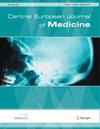Diagnosis of paediatric airway foreign body: is it easy?
引用次数: 1
Abstract
Foreign-body aspiration in children results in diagnostic problems, mainly because of nonspecific signs. Therefore, in this study, we placed particular stress on false-positive and -negative predictors. Charts of 139 consecutive paediatric patients aged 6.0 months to 15.5 years who underwent bronchoscopy for a suspected foreign body aspiration were analysed retrospectively. A foreign body was found in 95 cases (68%). The anamnesis was positive in 91%. Cough was the most common clinical symptom (91%) with a sensitivity and specificity of 94% and 23%, respectively. There were no significant correlations between clinical symptoms and the locations of foreign bodies. The majority of focal hyperinflation (24%) and atelectasis (15%) were seen in chest radiographs, with a sensitivity and specificity of 33% and 89% (hyperinflation) and 15% and 82% (atelectasis), respectively. Chest X-rays were normal in 46 cases; however, an object was removed in 25. Persistent infiltrates were present in 14 X-rays, and a foreign body was extracted during bronchoscopy in 4. A highly significant correlation between the type of foreign body and radiological signs was noted (p = 0.00001). Anamnesis, clinical symptoms, and radiological findings are helpful in confirming aspiration, but can be misleading. Chronic or recurrent pneumonia should prompt further bronchoscopic diagnosis.小儿气道异物的诊断容易吗?
儿童异物吸入导致诊断问题,主要是因为非特异性体征。因此,在本研究中,我们特别强调假阳性和阴性预测因子。回顾性分析139例年龄在6.0个月至15.5岁之间因疑似异物吸入而行支气管镜检查的患儿的病历。异物95例(68%)。91%的患者健忘率为阳性。咳嗽是最常见的临床症状(91%),敏感性和特异性分别为94%和23%。临床症状与异物位置无明显相关性。大多数局灶性过度膨胀(24%)和肺不张(15%)出现在胸片上,其敏感性和特异性分别为33%和89%(过度膨胀)和15%和82%(肺不张)。46例胸部x线检查正常;然而,一个物体在25年被移除。14例出现持续浸润,4例在支气管镜检查时发现异物。发现异物类型与影像学征象高度相关(p = 0.00001)。记忆、临床症状和影像学表现有助于确认误吸,但可能会产生误导。慢性或复发性肺炎应提示进一步的支气管镜诊断。
本文章由计算机程序翻译,如有差异,请以英文原文为准。
求助全文
约1分钟内获得全文
求助全文

 求助内容:
求助内容: 应助结果提醒方式:
应助结果提醒方式:


